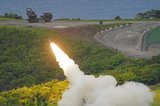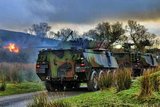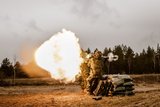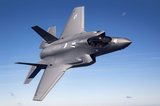Mattis visits China amid Korea talks, strategic tensions
US Secretary of Defense James Mattis will make his first visit to China in the week of 25 June amid rising tensions between the two countries but also a deep need for Beijing's support in nuclear talks with North Korea.
Mattis told reporters on 24 June that he wants to ‘take measure’ of China's strategic ambitions after it positioned weaponry on disputed islets in the South China Sea and is seeking to project its military power deep into the Pacific.
But in a four-day trip that will also include South Korea and Japan, the Pentagon chief also hopes to confirm China's commitment to pressuring North Korea to give up its nuclear weapons, after historic talks between US President Donald Trump and Kim Jong Un in Singapore.
The US, China, Japan and South Korea ‘have a common goal: the complete, irreversible and verifiable denuclearisation of the Korean peninsula,’ Mattis said.
In Beijing from 26-28 June, Mattis will meet with senior Chinese defence officials.
Then he will travel to Seoul for talks with his South Korean counterpart Song Young-moo, followed by a stop 29 June in Japan to see Defence Chief Itsunori Onodera.
Those meetings are aimed at reassuring both allies that Washington's regional defence commitment remains unchanged after Trump unexpectedly announced on 12 June that the US would suspend a major joint military exercise in South Korea following his meeting with Kim.
The visit to China comes amid bilateral strains that cross multiple sectors. The Trump administration is challenging China on trade, theft of industrial secrets, and cyberthreats.
In the defence sector, China's decision to position military hardware in built-up atolls in the South China Sea has sparked new security concerns throughout Southeast Asia.
Signalling Washington's displeasure, in May 2018 the Pentagon disinvited China from the 2018 Rim of the Pacific Exercise, in which some two dozen navies train together for mostly civilian missions.
Weeks later at the Shangri-la Dialogue security conference in Singapore, Mattis slammed China for showing contempt of other nations' interests in the South China Sea.
Mattis said: ‘Despite China's claims to the contrary, the placement of these weapon systems is tied directly to military use for the purposes of intimidation and coercion.’
The Chinese, who say the weaponry is only defensive in nature, retorted that Mattis had made ‘irresponsible comments’ that ‘cannot be accepted.’
Mattis has visited Asia seven times in his 17 months since becoming Defense Secretary, but not China. He has yet to meet the new Chinese Defence Minister, Wei Fenghe.
He said the talks in Beijing seek to scope out China's long-term strategic intentions and determine possible areas of military-to-military cooperation.
He declined to characterise the relationship, saying that could ‘poison the well’ before he meets his counterparts.
Mattis said: ‘I'm going there to get what I consider to be straight from them what they see for a strategic relationship. I'm going there to have a conversation.’
But speaking separately a senior Pentagon official called the US and China ‘strategic competitors’ and suggested that Washington needs to keep up the pressure over the South China Sea buildup.
The Rimpac disinvite could be ‘just a first step’, the official said.
Chinese Defence Ministry Spokesman Ren Guoqiang said Mattis was visiting Beijing at Wei's invitation.
Ren said in a statement: ‘It is in the common interests of both China and the United States to develop a healthy and stable bilateral military relationship. Beijing hopes that the United States and China will walk towards each other and work together to make the bilateral military relationship an important stablising factor in the relationship between the two countries.’
Mattis will also be adding his voice to North Korea talks, urging China to hold firm on commercial pressure on Pyongyang.
He said he has had daily discussions on the talks with the lead US negotiator, Secretary of State Mike Pompeo.
The senior US defense official said they are hoping to see a concrete outcome, including a timeline for commitments by Pyongyang, ‘soon.’
Mattis tied the suspension of exercises to the getting concrete results.
He said: ‘We'll see if they continuing negotiations keep them that way.’
Mattis meanwhile confirmed that US officials are awaiting the imminent release by Pyongyang of the remains of US servicemen who died in the Korean war in the early 1950s.
Preparations to receive the remains have been made, he said, and ‘We're optimistic that it will begin.’
More from Defence Notes
-
![How might European countries look to tackle drone incursions?]()
How might European countries look to tackle drone incursions?
Disruption of infrastructure in Europe, whether by cyberattack, physical damage to pipelines or uncrewed aerial vehicles flying over major airports, as has happened more recently, is on the rise. What is the most effective way of countering the aerial aspect of this not-so-open warfare?
-
![Taiwan approved for $11 billion weapon purchase from US]()
Taiwan approved for $11 billion weapon purchase from US
The US State Department’s approval of a multi-billion-dollar sale of weapons to Taiwan includes tactical mission networks equipment, uncrewed aerial systems, artillery rocket systems and self-propelled howitzers as well as anti-tank guided missiles.
-
![Ireland spells out $2.3 billion shopping list in five-year defence spending plan]()
Ireland spells out $2.3 billion shopping list in five-year defence spending plan
Ireland’s multi-annual investment in capital defence spending is set to rise from €300m in 2026 to €360m in 2029–2030 with major upgrades across land, air, maritime and cyber domains.
-
![Canada to deepen integration of multi-domain capabilities to strengthen its defences]()
Canada to deepen integration of multi-domain capabilities to strengthen its defences
The Canadian Department of National Defence has created new organisations to manage the procurement and integration of all-domain solutions and allocated US$258.33 million to strengthen production capacities.
-
![US National Security Strategy prioritises advanced military capabilities and national industry]()
US National Security Strategy prioritises advanced military capabilities and national industry
The 2025 NSS has emphasised investment in the US nuclear and air defence inventory and national industry, but it leaves multiple unanswered questions on how the White House will implement this approach.
-
![Canada set to look away from its neighbour and across the Atlantic for partners]()
Canada set to look away from its neighbour and across the Atlantic for partners
While non-EU UK struggles to join the Security Action for Europe initiative, which provides loans for defence programmes, Canada has become the first country outside Europe to get access – and did so for a nominal fee.
























